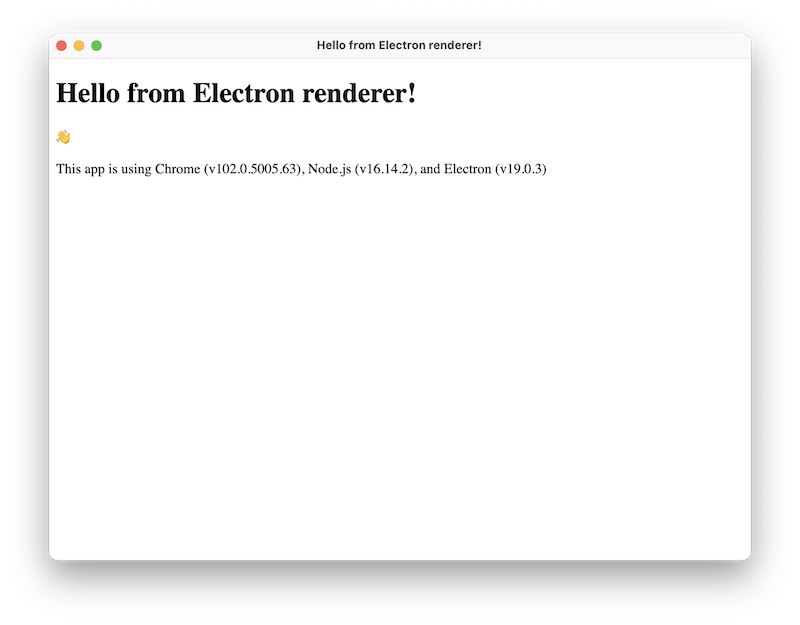使用预加载脚本
学习目标
在本教程的这一部分,您将了解什么是预加载脚本,以及如何使用它来安全地将特权 API 暴露给渲染进程。您还将学习如何使用 Electron 的进程间通信 (IPC) 模块在主进程和渲染进程之间进行通信。
什么是预加载脚本?
Electron 的主进程是一个具有完整操作系统访问权限的 Node.js 环境。除了 Electron 模块,您还可以访问 Node.js 内置模块,以及通过 npm 安装的任何包。另一方面,渲染进程运行网页,出于安全原因,默认情况下不运行 Node.js。
为了连接 Electron 的不同进程类型,我们需要使用一个特殊的脚本,称为预加载脚本。
使用预加载脚本增强渲染器
BrowserWindow 的预加载脚本在一个既能访问 HTML DOM 又能访问有限的 Node.js 和 Electron API 子集的上下文中运行。
从 Electron 20 开始,预加载脚本默认是沙箱化的,不再具有对完整 Node.js 环境的访问权限。实际上,这意味着您有一个经过 polyfill 处理的 require 函数,它只能访问有限的 API。
| 可用的 API | 详细信息 |
|---|---|
| Electron 模块 | 渲染进程模块 |
| Node.js 模块 | events、timers、url |
| Polyfilled 全局对象 | Buffer、process、clearImmediate、setImmediate |
有关更多信息,请查看 进程沙箱 指南。
预加载脚本会在 Web 页面加载到渲染进程之前注入,类似于 Chrome 扩展程序的 内容脚本。要为需要特权访问的渲染器添加功能,您可以通过 contextBridge API 定义 全局 对象。
为了演示这个概念,您将创建一个预加载脚本,该脚本将您的应用程序的 Chrome、Node 和 Electron 版本暴露给渲染进程,并将其放在一个名为 versions 的全局变量中。
添加一个新的 preload.js 脚本,该脚本将 Electron 的 process.versions 对象的选定属性暴露给渲染进程,并将其作为 versions 全局变量。
const { contextBridge } = require('electron')
contextBridge.exposeInMainWorld('versions', {
node: () => process.versions.node,
chrome: () => process.versions.chrome,
electron: () => process.versions.electron
// we can also expose variables, not just functions
})
要将此脚本附加到渲染进程,请在 BrowserWindow 构造函数中的 webPreferences.preload 选项中传递其路径。
const { app, BrowserWindow } = require('electron')
const path = require('node:path')
const createWindow = () => {
const win = new BrowserWindow({
width: 800,
height: 600,
webPreferences: {
preload: path.join(__dirname, 'preload.js')
}
})
win.loadFile('index.html')
}
app.whenReady().then(() => {
createWindow()
})
这里使用了两个 Node.js 概念:
__dirname字符串指向当前执行脚本的路径(在此情况下,是您项目的根文件夹)。path.joinAPI 将多个路径段连接在一起,创建可在所有平台上使用的组合路径字符串。
此时,渲染进程可以访问 versions 全局变量,因此让我们在窗口中显示该信息。可以通过 window.versions 或直接 versions 来访问此变量。创建一个 renderer.js 脚本,该脚本使用 document.getElementById DOM API 来替换具有 id 属性为 info 的 HTML 元素的显示文本。
const information = document.getElementById('info')
information.innerText = `This app is using Chrome (v${versions.chrome()}), Node.js (v${versions.node()}), and Electron (v${versions.electron()})`
然后,修改您的 index.html,添加一个 id 属性为 info 的新元素,并附加您的 renderer.js 脚本。
<!DOCTYPE html>
<html>
<head>
<meta charset="UTF-8" />
<meta
http-equiv="Content-Security-Policy"
content="default-src 'self'; script-src 'self'"
/>
<meta
http-equiv="X-Content-Security-Policy"
content="default-src 'self'; script-src 'self'"
/>
<title>Hello from Electron renderer!</title>
</head>
<body>
<h1>Hello from Electron renderer!</h1>
<p>👋</p>
<p id="info"></p>
</body>
<script src="./renderer.js"></script>
</html>
在完成上述步骤后,您的应用程序应该看起来像这样:

代码应该看起来像这样:
- main.js
- preload.js
- index.html
- renderer.js
const { app, BrowserWindow } = require('electron/main')
const path = require('node:path')
const createWindow = () => {
const win = new BrowserWindow({
width: 800,
height: 600,
webPreferences: {
preload: path.join(__dirname, 'preload.js')
}
})
win.loadFile('index.html')
}
app.whenReady().then(() => {
createWindow()
app.on('activate', () => {
if (BrowserWindow.getAllWindows().length === 0) {
createWindow()
}
})
})
app.on('window-all-closed', () => {
if (process.platform !== 'darwin') {
app.quit()
}
})
const { contextBridge } = require('electron/renderer')
contextBridge.exposeInMainWorld('versions', {
node: () => process.versions.node,
chrome: () => process.versions.chrome,
electron: () => process.versions.electron
})
<!DOCTYPE html>
<html>
<head>
<meta charset="UTF-8" />
<meta
http-equiv="Content-Security-Policy"
content="default-src 'self'; script-src 'self'"
/>
<meta
http-equiv="X-Content-Security-Policy"
content="default-src 'self'; script-src 'self'"
/>
<title>Hello from Electron renderer!</title>
</head>
<body>
<h1>Hello from Electron renderer!</h1>
<p>👋</p>
<p id="info"></p>
</body>
<script src="./renderer.js"></script>
</html>
const information = document.getElementById('info')
information.innerText = `This app is using Chrome (v${window.versions.chrome()}), Node.js (v${window.versions.node()}), and Electron (v${window.versions.electron()})`
进程间通信
如上所述,Electron 的主进程和渲染进程具有不同的职责,并且不可互换。这意味着不能直接从渲染进程访问 Node.js API,也不能从主进程访问 HTML 文档对象模型 (DOM)。
解决此问题的方法是使用 Electron 的 ipcMain 和 ipcRenderer 模块进行进程间通信 (IPC)。要从网页发送消息到主进程,您可以使用 ipcMain.handle 设置主进程处理程序,然后暴露一个调用 ipcRenderer.invoke 来触发预加载脚本中的处理程序的函数。
为了说明这一点,我们将向渲染器添加一个名为 ping() 的全局函数,该函数将从主进程返回一个字符串。
首先,在您的预加载脚本中设置 invoke 调用。
const { contextBridge, ipcRenderer } = require('electron')
contextBridge.exposeInMainWorld('versions', {
node: () => process.versions.node,
chrome: () => process.versions.chrome,
electron: () => process.versions.electron,
ping: () => ipcRenderer.invoke('ping')
// we can also expose variables, not just functions
})
请注意,我们将 ipcRenderer.invoke('ping') 调用包装在一个辅助函数中,而不是直接通过 context bridge 暴露 ipcRenderer 模块。您绝不应该直接通过预加载脚本暴露整个 ipcRenderer 模块。这会使您的渲染器能够向主进程发送任意 IPC 消息,这成为恶意代码的强大攻击向量。
然后,在主进程中设置您的 handle 监听器。我们这样做是在加载 HTML 文件之前,以确保在从渲染器发出 invoke 调用之前,处理程序已准备就绪。
const { app, BrowserWindow, ipcMain } = require('electron/main')
const path = require('node:path')
const createWindow = () => {
const win = new BrowserWindow({
width: 800,
height: 600,
webPreferences: {
preload: path.join(__dirname, 'preload.js')
}
})
win.loadFile('index.html')
}
app.whenReady().then(() => {
ipcMain.handle('ping', () => 'pong')
createWindow()
})
一旦设置了发送者和接收者,您就可以通过刚刚定义的 'ping' 通道从渲染器发送消息到主进程。
const func = async () => {
const response = await window.versions.ping()
console.log(response) // prints out 'pong'
}
func()
有关使用 ipcRenderer 和 ipcMain 模块的更深入解释,请查看完整的 进程间通信 指南。
总结
预加载脚本包含在 Web 页面加载到浏览器窗口之前运行的代码。它既可以访问 DOM API,也可以访问 Node.js 环境,并且通常用于通过 contextBridge API 将特权 API 暴露给渲染器。
由于主进程和渲染进程的职责大相径庭,Electron 应用通常会使用预加载脚本来设置进程间通信 (IPC) 接口,以在两种进程之间传递任意消息。
在教程的下一部分,我们将向您展示为应用程序添加更多功能的资源,然后教您如何将应用程序分发给用户。